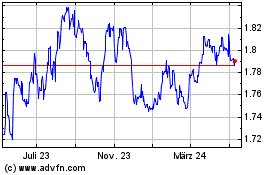Commodity Currencies Slide Amid Risk Aversion
16 November 2023 - 3:25AM
RTTF2
Commodity currencies such as Australia, the New Zealand and the
Canadian dollars weakened against their major currencies in the
Asian session on Thursday amid risk aversion, as investors became
cautious to a slew of economic data emerging from the region,
including from Australia, Japan and China. They also reacted to
tamer than expected U.S. consumer price inflation data, reinforcing
expectations the U.S. Fed is done raising interest rates.
Crude oil prices tumbled after data showed a sharp increase in
U.S. crude stockpiles and a big jump in crude production. West
Texas Intermediate Crude oil futures for December lost $1.60 or 2
percent at $76.66 a barrel, falling for the first time in five
sessions.
Meanwhile, the Australian dollar slightly rose against its major
after the release of Australia's jobs data. Thereafter, the
currency started reversing.
In economic news, the jobless rate in Australia came in at a
seasonally adjusted 3.7 percent in October, the Australian Bureau
of Statistics said on Thursday. That was in line with expectations
and up from 3.6 percent in September. The Australian economy added
55,000 jobs last month, blowing away forecasts for an increase of
20,000 jobs following the addition of 6,700 jobs in the previous
month. The participation rate improved to 67.0 percent, beating
forecasts for 66.7 percent, which would have been unchanged from
September. In the Asian trading today, the Australian dollar fell
to a 2-day low of 1.6770 against the euro, from yesterday's closing
value of 1.6669. The aussie may test support around the 1.69
area.
Against the U.S. and the Canadian dollars, the aussie dropped to
2-day lows of 0.6461 and 0.8859 from Wednesday's closing quotes of
0.6512 and 0.8910, respectively. If the aussie extends its
downtrend, it is likely to find support around 0.63 against the
greenback and 0.87 against the loonie.
The aussie edged down to 97.75 against the yen, from yesterday's
closing value of 98.46. On the downside, 95.00 is seen as the next
support level for the aussie.
The NZ dollar fell to 2-day lows of 1.8153 against the euro and
90.31 against the yen, from yesterday's closing quotes of 1.8005
and 91.16, respectively. If the kiwi extends its downtrend, it is
likely to find support around 1.83 against the euro and 87.00
against the yen.
Against the U.S. and the Australian dollars, the kiwi slipped to
2-day lows of 0.5971 and 1.0833 from Wednesday's closing quotes of
0.6029 and 1.0802, respectively. The kiwi is likely to find support
around 0.58 against the greenback and 1.09 against the aussie.
The Canadian dollar fell to a 2-day low of 1.3713 against the
U.S. dollar, from yesterday's closing value of 1.3684. On the
downside, 1.38 is seen as the next support level for the
loonie.
Against the yen and the euro, the loonie dropped to 110.31 and
1.4861 from Wednesday's closing quotes of 110.50 and 1.4852,
respectively. If the loonie extends its downtrend, it is likely to
find support 108.00 against the yen and 1.49 against the euro.
Looking ahead, Canada housing starts for October, U.S. weekly
jobless claims, U.S. export and import prices data for October,
U.S. industrial and manufacturing productions data for October and
U.S. NAHB housing market index for November are due to be released
in the New York session.
Euro vs NZD (FX:EURNZD)
Forex Chart
Von Jun 2024 bis Jul 2024

Euro vs NZD (FX:EURNZD)
Forex Chart
Von Jul 2023 bis Jul 2024
